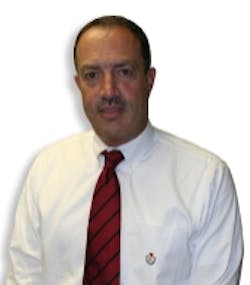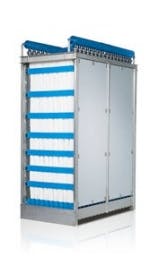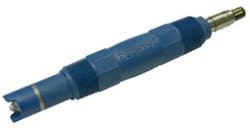Retrofitting Existing MBR Systems with Next-Generation MBR Technology
• Improving effluent quality and reducing footprint
By John Koch and Antonia von Gottberg, Koch Membrane Systems Inc.
Over the past two decades, membrane bioreactors with submerged membrane modules have emerged as an attractive choice for the next generation of wastewater treatment plants required to meet stringent effluent goals. The technology, in which ultrafiltration membrane modules are submerged in the activated sludge to provide the liquid solid separation process, offers improved effluent quality and a substantially smaller footprint compared to the combination of a conventional wastewater treatment plant followed by filtration or ultrafiltration.
MBR systems have been installed in thousands of municipal and industrial wastewater treatment plants of all sizes. These include a wide variety of challenging wastewater applications such as paper mills, breweries, food processors, chemical plants and textile manufacturers, as well as municipal wastewater treatment plants.
As the technology has matured, many MBR owners have become concerned with the membrane's proprietary nature, which is critically important to the MBR process. The membrane filtration modules used in MBR applications are typically designed with either hollow fibers or flat sheet panels, and are based on proprietary products that may not be compatible with other brands. Furthermore, electromechanical equipment supporting the membrane operation can also take many forms and modes of operation, exacerbating compatibility issues between different membrane manufacturers.
Owners increasingly do not want to be dependent on a single manufacturer. In addition, existing MBR owners want the option of easily replacing older membrane modules with the newest technology, which may include greater capacity with less energy consumption. Operators installing new systems also want interchangeability to ensure competitive pricing and protect against product obsolescence. Koch Membrane Systems,' PURON™ UF modules are ideal for retrofitting older MBR systems.
What to consider when retrofitting an MBR plant
In most cases, the decision to retrofit an existing MBR plant is generally made when the existing MBR is deficient in some way -- either the plant is not producing the required quality or cannot treat the required wastewater volume.
In many cases, the membrane supplier can improve plant performance simply by changing operating conditions. However, sometimes the membranes have reached the end of their useful life and need to be replaced. Typical reasons for membrane replacement include fiber breakage, permeability loss, and module clogging.
When retrofitting an MBR system, owners should consider a number of issues including physical module dimensions, MBR system performance and membrane operation sequences.
Module physical dimensions must accommodate existing size and layout
The first rule of a retrofit is that the new modules must be able to accommodate the existing tank size and module layout. Thus, the new module's frame must meet the necessary exterior dimensions (height, width, length). The membrane module must also provide an equal or greater flow capacity to support the capacity requirements of the MBR facility.
Performance of biological system affects retrofit of an existing MBR system
Plant operators should begin planning for a retrofit by analyzing overall plant performance. Any process issues must be identified and corrected before new membrane modules are installed. Poor bioreactor performance may result in membrane performance problems, which, in most cases, cause reduced permeability that results in excessive membrane cleaning. In such situations, changes to the biological treatment system may be needed to improve the system performance; simply changing the modules may not be sufficient and will not compensate for poor bioreactor design.
Module operation must support system process
Each MBR manufacturer has optimized performance in different ways, depending on the particular membrane module and its configuration. Careful consideration is required to evaluate the existing equipment that supports backwashing, air scouring and chemical cleaning sequences. This equipment may need modification or upgrade with a membrane retrofit.
For example, some systems backwash the membranes with permeate while others do not. This choice has typically been made based on the robustness of the membrane when pressure is applied from the opposite direction. Typically, flat sheet membranes and some unsupported hollow fibers cannot be backwashed. Therefore, the necessary piping and pumping capacity for backwashing may not be in place.
Moreover, membrane manufacturers use different air scour flow rates and cycle times for those systems that can cycle the delivery of air scour air. Therefore, retrofit installations may require adjustments to the air scouring sequence (typically a programming issue), and changes to the size of blowers, piping and the position of automatic valves to move air.
Example of MBR technology used in retrofitting existing MBR systems
An example of a second-generation module that optimizes both membrane and module design is the PURON module, a single header, submerged hollow fiber UF module that has been used to retrofit many existing MBR plants.
The fibers are arranged in bundles and submerged vertically into the activated sludge. Air scouring, carried out at regular intervals, maintains the membrane module filtration rate. An air nozzle is integrated into the center of the bundles to apply the air needed for scouring to maintain membrane permeability during operation. The central arrangement of the air nozzles inside the membrane bundles reduces energy consumption, since the air is injected where it can effectively scour the full length of the fibers, minimizing the collection of solids within the fibers that would otherwise foul most MBR membranes.
The module design ensures that hair and other fibrous material are removed reliably from the module eliminating membrane clogging and fouling. A special feature of the PURON membrane is the mechanical strength provided by a reinforcing braid which is incorporated in the construction of the hollow fiber membrane.
Unlike most flat sheet and some hollow fiber membranes that do not allow backflushing, the PURON membrane controls fouling and maintains permeability by introducing a small portion of the filtrate through the fiber pores from the inside-out at timed intervals. The hollow fibers provide significantly higher membrane surface area and higher filtration capacity within the same module footprint as compared to flat sheet membrane designs.
Retrofit Examples
Many wastewater treatment plant operators have opted to replace their first-generation MBR modules with next-generation modules, primarily to gain the benefits of improved membrane performance via energy efficiency and reduced membrane fouling. The two plants shown below have been retrofitted with the Koch Membrane Systems PURON second-generation membrane modules.
Municipal wastewater plant improves water quality
A community north of France had been using a municipal MBR to treat the wastewater using a double-header design since 2000. The biological treatment process includes chemical phosphorus removal, nitrification and denitrification. Reliability and energy consumption of the existing double-header hollow fiber membrane modules never met the operator's expectations, and the plant owner retrofitted the system with PURON membrane modules in 2006. Figure 4 shows two old modules being removed and one new module used for the retrofit.
Retrofitting allows operators to take advantage of best available technology
The PURON single header module from Koch Membrane Systems offers the opportunity to replace earlier MBR membrane technology while improving performance such as reduced fouling and lower energy consumption. The unique, free-floating fiber tips, combined with central aeration, ensure stable filtration during plant operation, long membrane life, and low operating costs by reducing energy and chemical cleaning costs. KMS also employs a team of skilled field service and design engineers to assist companies with module retrofitting.
The FLOW LINES DESIGN is a registered trademark of Koch Membrane Systems Inc. in the U.S.
PURON is a trademark of Koch Membrane Systems GmbH and is registered in Germany and other countries.
Koch Membrane Systems Inc. is a Koch Chemical Technology Group, LLC Company.
WaterWorld Online - October 2010
###






